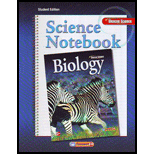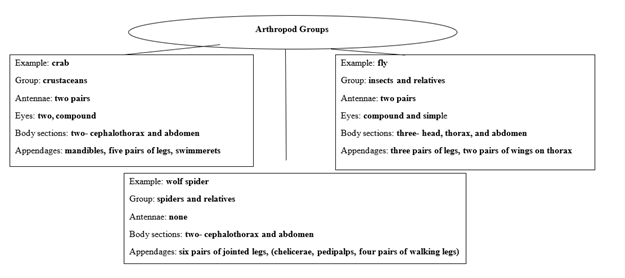
Concept explainers
To compare:
The common characteristics of the major arthropod groups.
Introduction:
Arthropods have segmented bodies and tough exoskeletons with jointed appendages.About 70 to 85 percent of all named animals are arthropods. The segmented body of an arthropod is divided into three regions: head, thorax and abdomen. Head forms the anterior part, thorax forms the middle part and abdomen forms the posterior part of an arthropod’s body.
Answer to Problem 5MI

Explanation of Solution
Arthropods are classified based on the structure of their segments, types of appendages and mouthparts.
Crustaceans- Crabs belong to this group. They live in marine, freshwater and terrestrial habitats. The head has two pairs of antennae, two compound eyes that are present on the tips of slender movable stalks and mandibles for chewing. Crustacean mandibles open and close from side to side. The appendages are branched. They have five pairs of legs. The first pair of legs called chelipeds has large claws to catch and crush food. Behind the next four pairs of walking legs are the swimmerets. Swimmerets are appendages used for reproduction and for swimming.
Spiders and relatives- Wolf spider belongs to the group of spiders. Spiders have two body sections- abdomen and cephalothorax. They lack antennae and have six pairs of jointed appendages. The first pair of appendages is modified into mouthparts called chelicerae. They function as fangs or pincers and are connected to poison gland. The second pair of appendage is called pedipalps and is used for sensing and holding prey. They also help in reproduction in male spiders. The other four pairs are used in locomotion.
Insects and their relatives- Fly belongs to the group of insects. Insects have three distinct body parts- head, thorax and abdomen. Head structures consist of two pairs of antennae, compound eyes, simple eyes, and mouth parts. They have three pairs of legs and two pairs of wings on the thorax. Some have only one pair of wings and some do not have wings at all.
Additional Science Textbook Solutions
Laboratory Experiments in Microbiology (11th Edition)
Human Anatomy & Physiology (11th Edition)
Microbiology: An Introduction (13th Edition)
Microbiology: An Introduction
Study Guide for Campbell Biology
 Human Anatomy & Physiology (11th Edition)BiologyISBN:9780134580999Author:Elaine N. Marieb, Katja N. HoehnPublisher:PEARSON
Human Anatomy & Physiology (11th Edition)BiologyISBN:9780134580999Author:Elaine N. Marieb, Katja N. HoehnPublisher:PEARSON Biology 2eBiologyISBN:9781947172517Author:Matthew Douglas, Jung Choi, Mary Ann ClarkPublisher:OpenStax
Biology 2eBiologyISBN:9781947172517Author:Matthew Douglas, Jung Choi, Mary Ann ClarkPublisher:OpenStax Anatomy & PhysiologyBiologyISBN:9781259398629Author:McKinley, Michael P., O'loughlin, Valerie Dean, Bidle, Theresa StouterPublisher:Mcgraw Hill Education,
Anatomy & PhysiologyBiologyISBN:9781259398629Author:McKinley, Michael P., O'loughlin, Valerie Dean, Bidle, Theresa StouterPublisher:Mcgraw Hill Education, Molecular Biology of the Cell (Sixth Edition)BiologyISBN:9780815344322Author:Bruce Alberts, Alexander D. Johnson, Julian Lewis, David Morgan, Martin Raff, Keith Roberts, Peter WalterPublisher:W. W. Norton & Company
Molecular Biology of the Cell (Sixth Edition)BiologyISBN:9780815344322Author:Bruce Alberts, Alexander D. Johnson, Julian Lewis, David Morgan, Martin Raff, Keith Roberts, Peter WalterPublisher:W. W. Norton & Company Laboratory Manual For Human Anatomy & PhysiologyBiologyISBN:9781260159363Author:Martin, Terry R., Prentice-craver, CynthiaPublisher:McGraw-Hill Publishing Co.
Laboratory Manual For Human Anatomy & PhysiologyBiologyISBN:9781260159363Author:Martin, Terry R., Prentice-craver, CynthiaPublisher:McGraw-Hill Publishing Co. Inquiry Into Life (16th Edition)BiologyISBN:9781260231700Author:Sylvia S. Mader, Michael WindelspechtPublisher:McGraw Hill Education
Inquiry Into Life (16th Edition)BiologyISBN:9781260231700Author:Sylvia S. Mader, Michael WindelspechtPublisher:McGraw Hill Education





